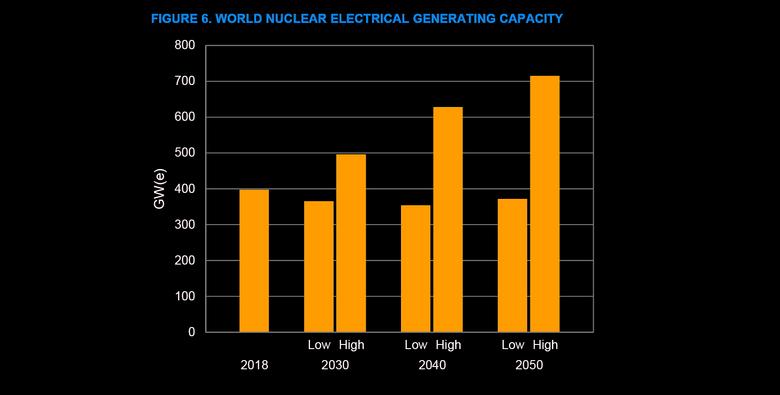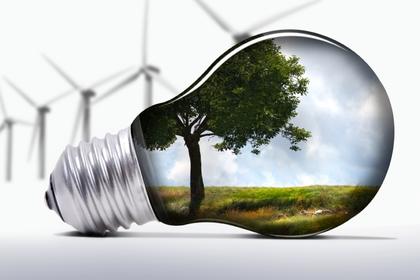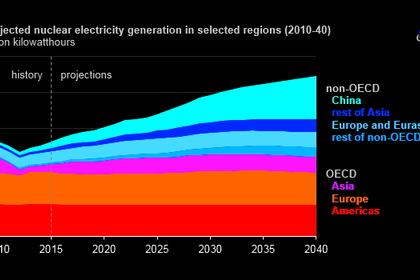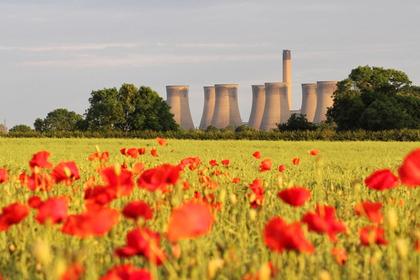ЯДЕРНАЯ ЭНЕРГЕТИКА - 2050: UPDOWN

МАГАТЭ - 10.09.2019 - МАГАТЭ опубликовала свои последние прогнозы о тенденциях на рынке энергии, электроэнергии и в сфере ядерной энергетики на период до 2050 года. В этом ежегодном докладе представлена комбинированная оценка вклада ядерной энергетики в мировую генерацию на будущие периоды в зависимости от того, будут ли введены в действие новые значительные мощности для компенсации возможного вывода некоторых реакторов из эксплуатации.
В 39-м выпуске этого доклада под названием «Оценка по энергии, электроэнергии и ядерной энергетике на период до 2050 года» подробно рассмотрены глобальные тенденции в сфере ядерной энергетики в разбивке по регионам. Представленные прогнозы1 состояния ядерных генерирующих мощностей даны в виде нижних и верхних оценок, которые отражают различные основные факторы, влияющие на использование этого низкоуглеродного источника энергии в мировом масштабе.
Согласно новым прогнозам на период до 2030 года в худшем случае генерирующие мощности сократятся примерно на 8%, а в лучшем — возрастут на 25%. На период до 2050 года в худшем случае прогнозируется падение на 6%, а в лучшем — рост на 80%. По сравнению с прошлым годом в новой оценке на период до 2050 года прогнозные цифры в лучшем случае меньше на 33 ГВт (эл.), а в худшем — больше на 15 ГВт (эл.).
Прогнозы на 2019 год по сравнению с предыдущими периодами содержат меньше факторов неопределенности ввиду последних заявлений о перспективах существующего парка АЭС в некоторых регионах и о долгосрочных планах по его расширению. Для компенсации возможного вывода некоторых реакторов из эксплуатации в силу их возраста, конкурентоспособности или прочих факторов может возникнуть потребность в значительных новых мощностях.
«В ближайшие годы ожидается стремительный рост мирового спроса на электроэнергию, так как странам для развития будет требоваться все больше энергии, — говорит заместитель Генерального директора МАГАТЭ, руководитель Департамента ядерной энергии Михаил Чудаков. — Без существенного увеличения вводимых в строй ядерных мощностей обеспечение достаточного энергетического баланса в мире, в целях устойчивого развития и смягчения последствий изменения климата, представляется весьма затруднительным».
В 2018 году ядерная энергетика обеспечивала порядка 10% всей вырабатываемой в мире электроэнергии, при этом на нее приходилось около трети всей низкоуглеродной электрогенерации. На сегодняшний день, с учетом 450 находящихся в эксплуатации во всем мире ядерных энергетических реакторов, достигнут почти рекордный уровень общей установленной мощности нетто — 399,7 ГВт (э).
В краткосрочной перспективе ожидается, что в некоторых регионах на перспективах роста ядерной энергетики по-прежнему будут сказываться низкие цены на природный газ и давление со стороны субсидируемых возобновляемых источников энергии. В то же время в нескольких регионах, прежде всего в развивающихся странах, по-прежнему наблюдается повышенный интерес к ядерной энергетике, и фактором поддержки для развития этого сектора потенциально могут служить обязательства в рамках Парижского соглашения и других инициатив.
__________
1 В прогнозах учтены как располагаемые мощности (в настоящее время поставляющие электроэнергию в сеть), так и установленные номинальные мощности (имеющиеся в наличии, но в настоящее время не поставляющие электроэнергию в сеть).
-----
NUCLEAR POWER - 2050: UPDOWN

IAEA - SEP 10 2019 - The IAEA has released its latest projections for energy, electricity and nuclear power trends through 2050. The annual report offers a mixed estimate of nuclear power's future contribution to global electricity generation, depending in part on whether significant new capacity can be added to offset potential reactor retirements.
The 39th edition of Energy, Electricity and Nuclear Power Estimates for the Period up to 2050 provides detailed global trends in nuclear power by region. Its projections1 for nuclear electrical generating capacity are presented as low and high estimates, reflecting different driving factors that have an impact on the worldwide deployment of this low carbon energy source.
The new projections to 2030 see generating capacity declining by some 8% in the low case and increasing by 25% in the high estimate. By 2050, it's seen falling by 6% in the low scenario and rising by 80% in the high case. Compared with last year, the new estimates to 2050 are down by 33 GW(e) in the high case and up by 15 GW(e) in the low case.
The 2019 projections contain fewer uncertainties compared with previous years due to recent announcements on the future of the existing fleet in some regions and long term plans for expansion. Significant new capacity may be needed to offset possible reactor retirements due to age, competitiveness or other factors.
"Global electricity demand is expected to rise sharply in coming years as countries need more power for development," said IAEA Deputy Director General Mikhail Chudakov, Head of the Department of Nuclear Energy. "Without a significant increase in the deployment of nuclear power, it will be difficult for the world to secure sufficient energy to achieve sustainable development and to mitigate climate change."
In 2018, nuclear power produced about 10% of the world's electricity, accounting for around one third of all low carbon electricity. As of today, the world's 450 operating nuclear power reactors have a near record level of 399.7 GW(e) total net installed capacity.
In some regions, over the short term the low price of natural gas and the impact of subsidized renewable energy sources are expected to continue to affect nuclear power's growth prospects. Still, interest in nuclear power remains strong in several regions, particularly in the developing world, and commitments agreed under the Paris Agreement and other initiatives have the potential to support its development.
__________
1 The projections consist of both available capacity (currently supplying electricity to the grid) and installed nominal capacity (available, but not currently supplying electricity to the grid).
-----
Earlier:

2019, September, 30, 15:10:00
ENERGY CHANGES CLIMATE
These three levers, each with their own potential to disrupt the market and offer new growth opportunities to the companies that leverage them, are often discussed in the energy industry: Digital technology, climate change, and dealing with risk

2019, September, 26, 13:25:00
CLEAN NUCLEAR POWER
Nuclear reactors are the unsung heroes as we set out to respond to the climate change challenge. The need for nuclear energy has never been greater - there simply is no other energy source which can deliver deep decarbonisation within the necessary timeframes.

2019, September, 24, 17:55:00
SLOW NUCLEAR ENERGY
“Stabilizing the climate is urgent, nuclear power is slow,” said Mycle Schneider, lead author of the report. “It meets no technical or operational need that low-carbon competitors cannot meet better, cheaper and faster.”
All Publications »
Tags:
NUCLEAR,
POWER,
ЯДЕРНАЯ,
ЭНЕРГЕТИКА










